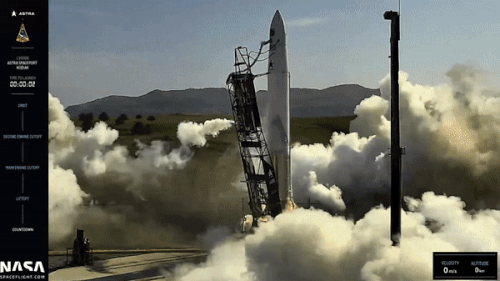
We now know what caused that memorable power slide during Astra's most recent launch.
The Bay Area company attempted its third orbital liftoff on Aug. 28, sending a two-stage rocket called Launch Vehicle 0006 (LV0006) skyward from Alaska's Pacific Spaceport Complex on a test mission for the U.S. military.
LV006 moved much farther laterally than vertically at first, sliding sideways off the pad before finding its footing and rising into the Alaska sky. But the 43-foot-tall (13 meters) rocket couldn't fully recover from its initial difficulties, and the mission was terminated 2.5 minutes after liftoff, right around "max-Q," the point when the mechanical stresses on a rocket are highest.
Video: Watch Astra's Rocket 3.2 launch on its 1st successful flight
Astra and the U.S. Federal Aviation Administration have been investigating the anomaly, and the company announced today (Oct. 12) that the inquiry has identified a root cause — a problem with the propellant-distribution system for LV006's five first-stage engines.
"On this launch, propellants leaked from the system, mixed, and became trapped in an enclosed space beneath the interface between the rocket and the launcher," Astra executive vice president and chief engineer Benjamin Lyon wrote in a blog post today.
"Those propellants were ignited by the engine exhaust, causing an overpressure event that severed the connection to the electronics that control the fuel pump, shutting down the engine less than one second after liftoff," he added. "This is why the rocket hovered until it could take off with only four engines producing thrust. The vehicle then returned to a normal trajectory, passing through max-Q. After that point, the four remaining engines did not have sufficient power to enable the vehicle to make orbit."
Get the Space.com Newsletter
Breaking space news, the latest updates on rocket launches, skywatching events and more!
Astra had not encountered this problem before, and the company has already taken steps to reduce the odds that it will happen again, Lyon said. For example, Astra has tweaked the design of its rocket-launcher interfaces so that propellants will not mix together even if they leak.
"On top of that, we've modified and re-qualified the propellant supply mechanism to minimize fuel leakage and also removed the cover to eliminate the confined space problem," Lyon wrote in today's update. "We've also improved our verification processes for both design and operations. Together, we believe these changes significantly reduce the likelihood of seeing a similar event in the future."
Those changes have been implemented on the company's next rocket, LV007, which will get a chance to fly soon. The rocket is scheduled to lift off from the Pacific Spaceport Complex during a window that runs from Oct. 27 to Oct. 31, Astra announced today. If that doesn't happen, a second window will open from Nov. 5 to Nov. 12.
Like LV006, LV007 will carry a test payload for the Department of Defense's Space Test Program, company representatives said.
Astra, which was founded in 2016, aims to secure a large portion of the small-satellite launch market with its line of mass-produced, cost-effective, ever-evolving small rockets. The company has attempted three orbital test flights to date.
The first try, which occurred in September 2020, failed because Astra's Rocket 3.1 suffered a guidance issue shortly after liftoff. Less than three months later, its successor made it to space but ran out of fuel just before reaching orbital velocity. Then came LV006 and its sideways shuffle.
Such issues are to be expected during a rocket's development, Astra representatives have said.
"Our team is looking forward to returning to flight and learning more about our launch system — consistent with our launch-and-learn philosophy," Astra co-founder, chairman and CEO Chris Kemp said in a statement today.
Mike Wall is the author of "Out There" (Grand Central Publishing, 2018; illustrated by Karl Tate), a book about the search for alien life. Follow him on Twitter @michaeldwall. Follow us on Twitter @Spacedotcom or Facebook.
Join our Space Forums to keep talking space on the latest missions, night sky and more! And if you have a news tip, correction or comment, let us know at: community@space.com.

Michael Wall is a Senior Space Writer with Space.com and joined the team in 2010. He primarily covers exoplanets, spaceflight and military space, but has been known to dabble in the space art beat. His book about the search for alien life, "Out There," was published on Nov. 13, 2018. Before becoming a science writer, Michael worked as a herpetologist and wildlife biologist. He has a Ph.D. in evolutionary biology from the University of Sydney, Australia, a bachelor's degree from the University of Arizona, and a graduate certificate in science writing from the University of California, Santa Cruz. To find out what his latest project is, you can follow Michael on Twitter.









